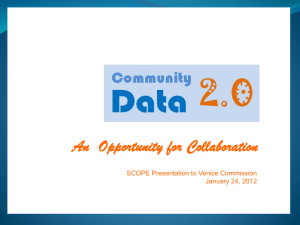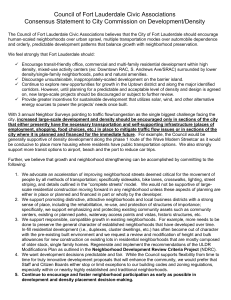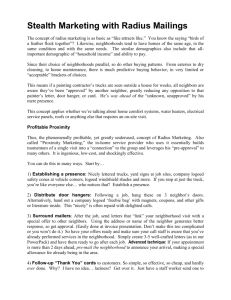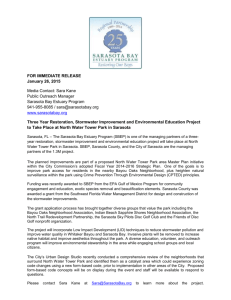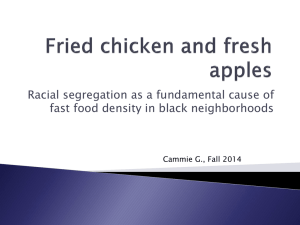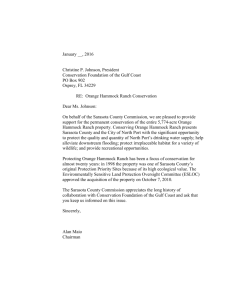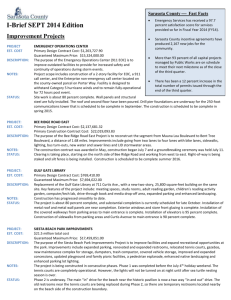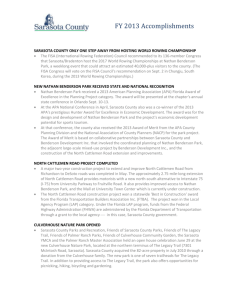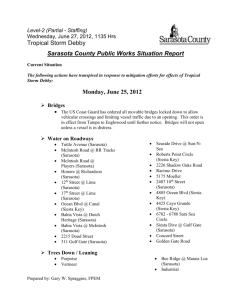June 2012 - Meeting Notes
advertisement
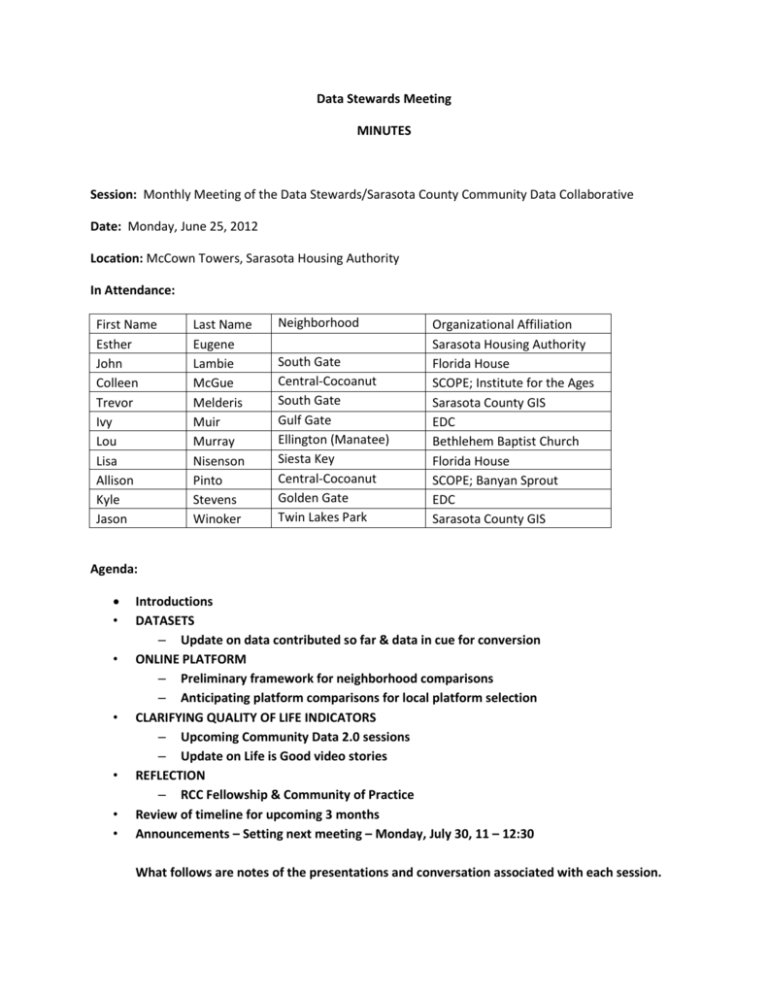
Data Stewards Meeting MINUTES Session: Monthly Meeting of the Data Stewards/Sarasota County Community Data Collaborative Date: Monday, June 25, 2012 Location: McCown Towers, Sarasota Housing Authority In Attendance: First Name Esther John Colleen Trevor Ivy Lou Lisa Allison Kyle Jason Last Name Eugene Lambie McGue Melderis Muir Murray Nisenson Pinto Stevens Winoker Neighborhood South Gate Central-Cocoanut South Gate Gulf Gate Ellington (Manatee) Siesta Key Central-Cocoanut Golden Gate Twin Lakes Park Organizational Affiliation Sarasota Housing Authority Florida House SCOPE; Institute for the Ages Sarasota County GIS EDC Bethlehem Baptist Church Florida House SCOPE; Banyan Sprout EDC Sarasota County GIS Agenda: • • • • • • Introductions DATASETS – Update on data contributed so far & data in cue for conversion ONLINE PLATFORM – Preliminary framework for neighborhood comparisons – Anticipating platform comparisons for local platform selection CLARIFYING QUALITY OF LIFE INDICATORS – Upcoming Community Data 2.0 sessions – Update on Life is Good video stories REFLECTION – RCC Fellowship & Community of Practice Review of timeline for upcoming 3 months Announcements – Setting next meeting – Monday, July 30, 11 – 12:30 What follows are notes of the presentations and conversation associated with each session. Data Stewards Meeting – June 25, 2012 Page 2 I. II. Introductions Everyone introduced themselves by name, neighborhood, and institutional/associational group affiliation (as a way of reinforcing our neighborhood-based and cross-scale/crosssector orientation). Ms. Eugene introduced us to the space: many of the residents of McCown Towers qualify for public housing or housing choice voucher. The residents include a mix of persons of different ethnicities, older adults, persons who are disabled, and veterans. Datasets: Those contributed so far to the Community Platform Who are we? (Demographics) i. All data available through census at the block scale and neighborhood boundaries Boundaries i. Neighborhoods ii. Census blocks iii. Census block groups iv. Census tracts v. Zip codes vi. School attendance zones vii. Voting precincts viii. Police precincts ix. Watersheds x. Commission districts xi. Provision of social services, flood zones, velocity zones all should be there as well What’s life like here? i. Stories: about 75 to be organized by neighborhood How are we doing? i. Social: tend to be negative, like Sherriff’s Data ii. Learning: school attendance, reading and math achievement from 3rd grade and high school iii. Civic involvement: registered voters iv. Health: infant mortality, low birth weight, health births, death by diabetes v. Economy: all American Community Survey data available at census tract level vi. Natural environment: impervious surfaces, green map data vii. Built environment: housing tenure, utilities viii. Transportation: bus routes What have we got? i. Parks & natural lands ii. Houses of worship iii. Libraries Data Stewards Meeting – June 25, 2012 Page 3 iv. v. vi. vii. viii. ix. x. Schools Businesses Nonprofit orgs Hospitals Fire stations Bus routes railways A. Comments and questions from Data Stewards on Data for Policy Making: o Data helps determine what indicators to use and indicators determine the data. o Use quality of life indicators identified from Community Data 2.0 sessions from citizens: citizen input ranked higher than professional input Mr. Murray talked about his experience where he lived in Michigan: everyone had data on the community except the community. Data is power. What data on positive indicators of social well-being could be collected? What other indicators of well-being? o Spirituality (social) o Information on adult learning: Lifelong Learning academy and SCTI (learning) o Advisory councils to different cities (civic involvement) o Food stamps and SSI, in terms of social dollars (economics) o Approach DCF to see what is available (economics) o Where are farmers markers? (economic) o Where is the barter economy (economic) o Large employers in a neighborhood (economic)? o Vacant commercial properties through property appraiser (built environment) o Foreclosures (built environment) o Water usage (built environment) o NAICS codes (built environment) III. Online Platform: The challenge of county-wide comparisons How to compare neighborhoods to all other areas of Sarasota County when not all areas have been identified as part of a neighborhood so far… Examined map of neighborhoods identified vs. map of census block group Group decided that we would only compare neighborhoods to neighborhoods, rather than filling them on: make it clear there will be an “opt-in” system. Users will be able to define their own boundaries Next month we will spend time looking at neighborhoods and the way the platform is being inhabited. Data Stewards Meeting – June 25, 2012 Page 4 IV. We will provide a guide to comparing with other community platforms for folks to look at them over time. In the meantime, Data Stewards are invited to continue sending along platforms to compare with our own. Clarifying Quality of Life Indicators Three Community Data 2.0 Workshops coming up: o Data 2.0: A Neighborkids’ Perspective – Saturday, July 14th from 9am-1pm at the Robert L. Taylor Complex o Data 2.0: Sarasota- mid-August, TBD o Data 2.0: A Older Adults’ Perspective- August 25th, Location TBD “Life is Good” Community Videos o Sarasota County Libraries o Other partners? o Mobile kiosk: just give one week of notice V. Reflection Resident Community Changemakers: fellows and community of practice i. Citizen and resident-centric, as opposed to institution-centric “Just in Time” Opportunities for Reflection: i. Lou Murray utilized this opportunity regarding data related to new polling places and transportation access focused on the community of Newtown VI. Announcements: Next meeting will take place on Monday, July 30 from 11am-12:30pm at Sarasota County Government building on 1660 Ringling Blvd.
